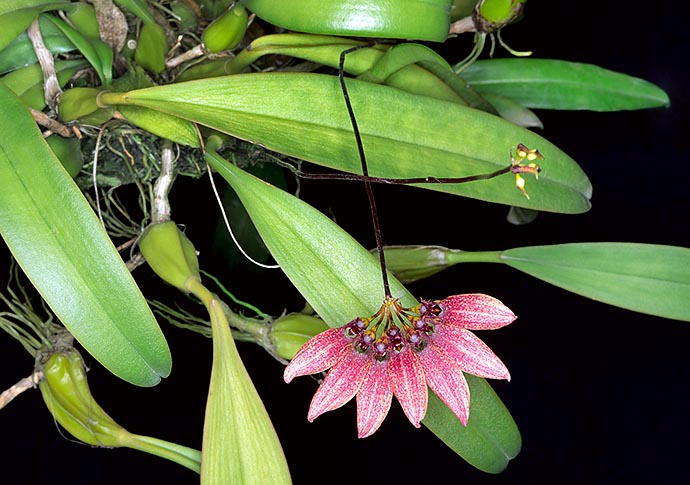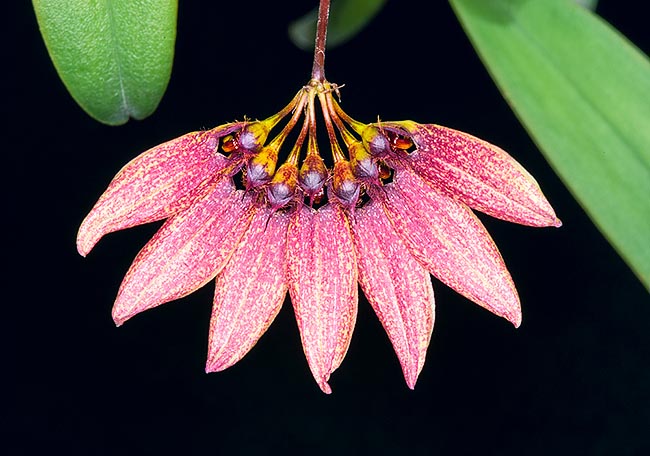Family : Orchidaceae

Text © Pietro Puccio

English translation by Mario Beltramini

Bulbophyllum flabellum-veneris is a miniature orchid, mainly epiphytic, of south-eastern Asia © Giuseppe Mazza
The species is native to Andaman Islands, Borneo, Cambodia, China (Hainan), Java, Laos, Malaysia, Moluccas, Myanmar, Sumatra, Thailand and Vietnam where it grows in the forests usually as epiphyte on the trunks covered by moss close to the soil, up to about 900 m of altitude.
The name of the genus is the combination of the Greek substantives “βολβός” (bolbos) = bulb and “φύλλον” (phyllon) = leaf, with reference to the leaves growing at the apex of the pseudobulbs; the name of the species is the combination of the Latin terms “flabellum” = fan and “Venus, -neris” = Venus, therefore fan of Venus, with reference to the shape of the inflorescence.
Common names: nan fang juan ban lan (Chinese).
The Bulbophyllum flabellum-veneris (J.Koenig) Aver. (2003) is an epiphytic species, rarely lithophytic, with sessile pseudobulbs on a filiform creeping rhizome, spaced of 2-3 cm, ovoid, grooved, with tetra or pentagonal section, about 1,6 cm long and of 1,3 cm of diameter, of pale green colour, provided at the apex with only one oblong, lanceolate leaf, 7-12 cm long and 1,5-3 cm broad, coriaceous.
Corymbiform inflorescence from the base of the pseudobulb, on an about 18 cm long scape, carrying 7-12 close flowers gathered in a semi-circle. Ovate dorsal sepal with pointed apex, 0,3-0,6 cm long, of violet purple colour with purple ciliate margins, oblong lateral sepals, merged up to almost the base, at times free at the apex, 1,5-2,5 cm long and 0,4 cm broad, of white, yellow or pale pink colour with red to brown spots thicker at the base, ovate-triangular petals, 0,3-0,5 cm long, violet purple with ciliate margins, mobile ovate labellum, curved, of yellow to orange colour, about 0,3 cm long. It reproduces by seed, in vitro, micropropagation and at amateurish level by division, with each section provided with at least 3-4 pseudobulbs.

As the name suggests, the inflorescence seems a splendid fan, worthy of Venus © Giuseppe Mazza
Waterings and nebulisations frequent during the vegetative period, but without stagnations, more spaced in winter, but without ever allowing the substratum to completely dry-up. Waterings and nebulisations are to be done with rainwater, by reverse osmosis or demineralised; for the fertilization, at intervals of 2-3 weeks during the growth period, may be utilized hydrosoluble balanced composts, with mcroelements, at ¼ of the dosage shown on the package.
It can be cultivated in pots or baskets with aerated and draining compost that may be formed by bark fragments and medium sliced charcoal or of coir, with possible addition of sphagnum if the atmosphere is too dry, or mounted on branches, bark, or cork rafts. The repottings, when necessary, are to be done at the vegetative restart when the new roots do appear.
The species is reported in the appendix II of the CITES (species whose trade is internationally ruled).
Synonyms: Epidendrum flabellum-veneris J.Koenig (1791); Ephippium lepidum Blume (1825); Cirrhopetalum gamosepalum Griff. (1851); Bulbophyllum griffithianum E.C.Parish & Rchb.f. (1874); Phyllorchis gamosepala (Griff.) Kuntze (1891); Phyllorkis gamosepala (Griff.) Kuntze (1891); Cirrhopetalum ciliatum Klinge(1898); Bulbophyllum lepidum (Blume) J.J.Sm. (1905); Bulbophyllum umbellatum J.J.Sm. (1905); Cirrhopetalum lepidum (Blume) Schltr. (1911); Bulbophyllum gamosepalum (Griff.) J.J.Sm. (1912); Bulbophyllum viscidum J.J.Sm. (1920); Cirrhopetalum siamense Rolfe ex Downie (1925); Cirrhopetalum gamosepalum Griff.(1851); Bulbophyllum rolfeanum (Rolfe ex Downie) Seidenf. & Smitinand (1961); Cirrhopetalum gagnepainii Guillaumin (1964); Cirrhopetalum viscidum (J.J.Sm.) Garay, Hamer & Siegerist (1994); Cirrhopetalum flabellum-veneris (J.Koenig) Seidenf. & Ormerod (1995); Bulbophyllum flabelloveneris (J. König) Seidenf. & Ormerod ex Aver. (2003).
→ For general notions about ORCHIDACEAE please click here.
